#259 Information: March 04, 1996
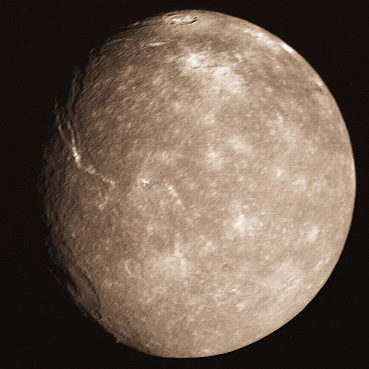
“Titania's tortured terrain is a mix of valleys and craters. NASA's interplanetary robot spacecraft Voyager 2 passed this moon of Uranus in 1986 and took the above photograph. The photograph was then transmitted back to earth by radio. The valleys of Titania resemble those on Ariel indicate that Titania underwent some unknown tumultuous resurfacing event in its distant past. Although Titania is Uranus' largest moon, it is still much smaller than Triton - the largest moon of Uranus' sister planet Neptune. Titania is essentially a large dirty iceball that orbits Uranus - it is composed of about half water-ice and half rock. Titania was discovered by William Hershel in 1787. Information: The Scale of the Universe Debate in April 1996"
Copyright: Public domain
#260 Information: March 05, 1996
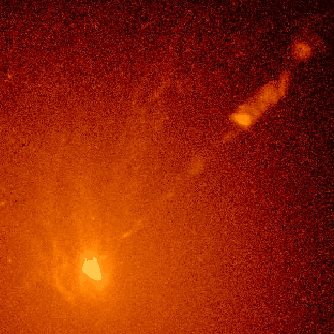
“The center of nearby giant galaxy M87 is a dense and violent place. In this 1994 photograph by the Hubble Space Telescope, a disk of hot gas was found to be orbiting at the center of this massive elliptical galaxy. The disk is evident on the lower left of the above photograph. The rotation speed of gas in this disk indicates the mass of the object the gas is orbiting, while the size of the disk indicates an approximate volume of the central object. These observations yield a central density so high that the only hypothesized object that could live there is a black hole. The picture also shows a highly energetic jet emanating from the central object. The jet is composed of fast moving charged particles and has broken into knots as small as 10 light years across. Information: The Scale of the Universe Debate in April 1996"
Copyright: Public domain
#261 Information: March 06, 1996
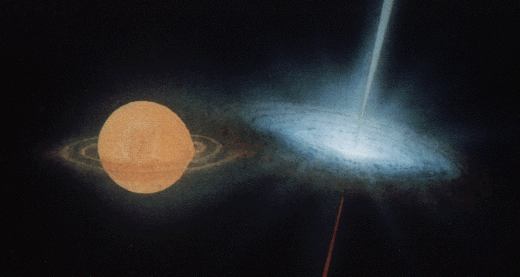
“SS433 is one of the most exotic star systems known to astronomers. Its unremarkable name stems from its inclusion in a catalog of stars which emit radiation characteristic of atomic hydrogen. Its very remarkable behavior stems from a compact object, a black hole or neutron star, which has produced an accretion disk with jets. As illustrated in this artist's vision of the SS433 system based on observational data, a massive, hot star (left) is locked in a mutual orbit with a compact object. Material transfers from the massive star into an accretion disk surrounding the compact object blasting out two jets of ionized gas in opposite directions - at about 1/4 the speed of light! Radiation from the jet tilted toward the observer is blueshifted, while radiation from the jet tilted away is redshifted. The binary system itself completes an orbit in about 13 days while the jets precess (wobble like a top) with a period of about 164 days. Are the jets from SS433 related to those from black holes at the centers of galaxies? Information: The Scale of the Universe Debate in April 1996"
Copyright: Public domain
#262 Information: March 07, 1996
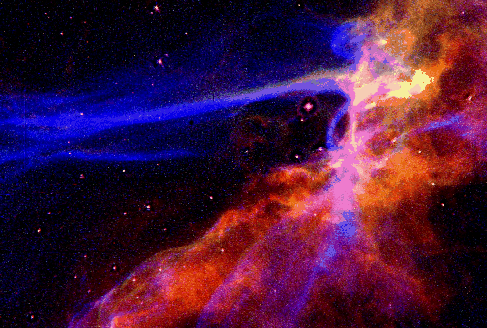
“A supernova explosion of a high-mass star results in fast moving blast waves. At the front of the waves shown above, ionized gas in the Veil Supernova Remnant rushes out from the explosion, sweeps up material, and breaks up many atoms into constituent ions and electrons. Observations with the Hubble Space Telescope in 1993 indicate that the blue shock wave was catapult away from the stellar explosion after the red shock wave and has yet to catch up to it in some regions. The Veil supernova remnant's has a very large angular size - six times the diameter of the full moon - and different parts of it are known as the "Cygnus Loop" and catalog numbers NGC 6960, NGC 6979, NGC 6992, and NGC 6995. Information: The Scale of the Universe Debate in April 1996"
Copyright: Public domain
#263 Information: March 08, 1996
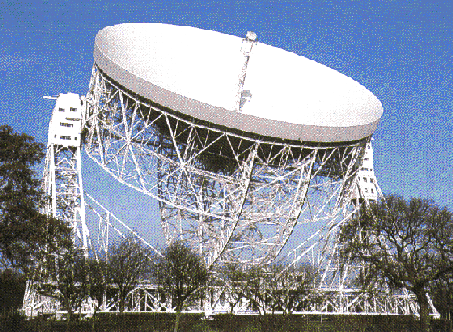
“Jodrell Bank in England is the home of the Lovell Telescope one of the largest radio telescopes in the world. Completed in 1957 under the direction of Bernard Lovell, the 250 ft. diameter dish was the largest steerable radio telescope. The telescope has been used to monitor extremely faint radio emissions from space, including the transmissions of the Pioneer spacecraft in the distant Solar System. The telescope has been used in many astronomical investigations, including the determination of structure in local interstellar gas, searches for pulsars, determining molecular abundances towards the Galactic center, and mapping hydrogen emission in galaxies. Currently, the telescope is not really for sale. Information: The Scale of the Universe Debate in April 1996"
Copyright: Public domain
#264 Information: March 09, 1996
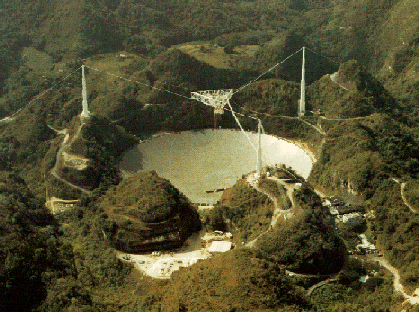
“The Arecibo radio telescope is currently the largest single-dish telescope in the world. First opening in 1963, this 305 meter (1000 foot) radio telescope resides in a natural valley of Puerto Rico. The Arecibo telescope has been used for many astronomical research projects, including searches and studies of pulsars, and mapping atomic and molecular gas in the Galaxy and the universe. As the Arecibo dish can also be used to send radio waves, it has bounced and recorded radiation off of planets in our Solar System, and has even broadcast messages to areas of the Galaxy that might contain intelligent extra-terrestrial life. Any person in the world may use the telescope, providing their proposal is selected by a review committee. Information: The Scale of the Universe Debate in April 1996"
Copyright: Public domain
#265 Information: March 10, 1996
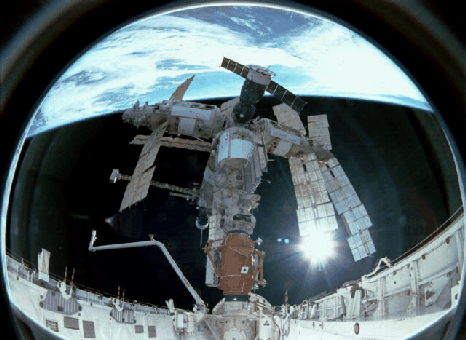
“The first module of the Russian Space Agency's Mir Space Station was launched into orbit 10 years ago (on February 20, 1986). Mir has since been substantially expanded in orbit by adding additional modules including the Kvant Astrophysics Module (1987) and recently a docking module. NASA's Space Shuttle Atlantis was modified to allow it to dock with Mir in 1995 (STS-71,, STS 74) beginning a series of Shuttle-Mir flights scheduled to continue through 1997. In this wide angle view - poised above planet Earth with sunlight glinting from solar panels - Mir and Atlantis are seen connected via the docking module from the perspective of the shuttle payload bay. The image is from an IMAX movie frame taken during the STS 74 mission. In late 1997, building on this jointly developed understanding and experience, the US and Russia will launch the first modules of the International Space Station. Information: The Scale of the Universe Debate in April 1996"
Copyright: Public domain
#266 Information: March 11, 1996
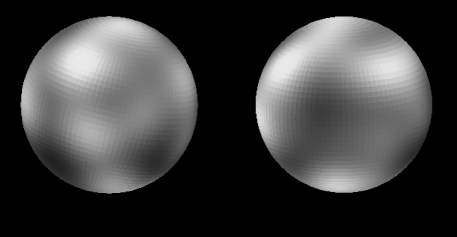
“No spacecraft from Earth has yet explored Pluto but astronomers have found ways of mapping its surface. A stunning map of this distant, diminutive planet, the first based on direct images, was revealed late last week in a Hubble Space Telescope press release. Above are two opposite hemisphere views of the computer constructed map of Pluto's surface (north is up). The grid pattern is due to the computer technique used where each grid element is over 100 miles across. The map is based on Hubble images made when Pluto was a mere 3 billion miles distant. It shows strong brightness variations - confirming and substantially improving upon ground based observations. While the brightness variations may be due to surface features like craters and basins they are more likely caused by regions of nitrogen and methane frost. The frost regions should show "seasonal" changes which can be tracked in future Hubble observations. Yes, Pluto is a planet even though it is only 2/3 the size of Earth's Moon! Information: The Scale of the Universe Debate in April 1996"
Copyright: Public domain
Upvote! Resteem! Comment! As you like it! Thank you for attention!